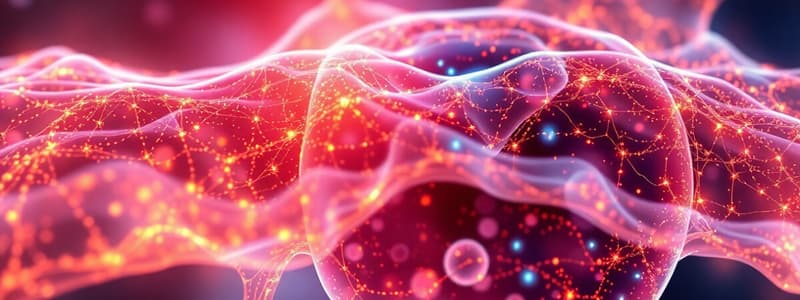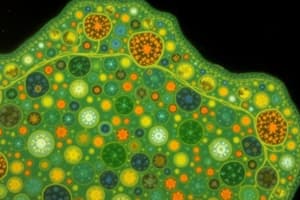Podcast
Questions and Answers
What is the primary structure of the plasma membrane as described by the Fluid Mosaic Model?
What is the primary structure of the plasma membrane as described by the Fluid Mosaic Model?
Which component of the plasma membrane is present only on the outer surface?
Which component of the plasma membrane is present only on the outer surface?
What characteristic of phospholipids makes them suitable for forming a bilayer?
What characteristic of phospholipids makes them suitable for forming a bilayer?
What role does cholesterol play in the plasma membrane?
What role does cholesterol play in the plasma membrane?
Signup and view all the answers
How do small molecules generally move across the plasma membrane compared to large molecules?
How do small molecules generally move across the plasma membrane compared to large molecules?
Signup and view all the answers
Which statement correctly differentiates between hydrophilic and hydrophobic regions of phospholipids?
Which statement correctly differentiates between hydrophilic and hydrophobic regions of phospholipids?
Signup and view all the answers
What kind of molecules typically require transmembrane proteins to cross the plasma membrane?
What kind of molecules typically require transmembrane proteins to cross the plasma membrane?
Signup and view all the answers
What term describes the model that explains the dynamic arrangement of phospholipids and proteins in the plasma membrane?
What term describes the model that explains the dynamic arrangement of phospholipids and proteins in the plasma membrane?
Signup and view all the answers
What is the primary reason that phospholipids arrange themselves with their hydrophobic tails facing each other in an aqueous solution?
What is the primary reason that phospholipids arrange themselves with their hydrophobic tails facing each other in an aqueous solution?
Signup and view all the answers
Which type of protein is integrated into the plasma membrane and contains hydrophobic regions?
Which type of protein is integrated into the plasma membrane and contains hydrophobic regions?
Signup and view all the answers
What role does cholesterol play in membrane fluidity at low temperatures?
What role does cholesterol play in membrane fluidity at low temperatures?
Signup and view all the answers
What role do carbohydrates play in plasma membranes?
What role do carbohydrates play in plasma membranes?
Signup and view all the answers
Which term describes the movement of water from an area of lower solute concentration to an area of higher solute concentration?
Which term describes the movement of water from an area of lower solute concentration to an area of higher solute concentration?
Signup and view all the answers
How do unsaturated fatty acids affect membrane fluidity compared to saturated fatty acids?
How do unsaturated fatty acids affect membrane fluidity compared to saturated fatty acids?
Signup and view all the answers
What is the effect of cholesterol on membrane fluidity?
What is the effect of cholesterol on membrane fluidity?
Signup and view all the answers
What is the primary difference between osmolarity and tonicity?
What is the primary difference between osmolarity and tonicity?
Signup and view all the answers
Which statement correctly describes passive transport?
Which statement correctly describes passive transport?
Signup and view all the answers
What distinguishes transmembrane proteins from other integral proteins?
What distinguishes transmembrane proteins from other integral proteins?
Signup and view all the answers
How do carrier proteins function in facilitated diffusion?
How do carrier proteins function in facilitated diffusion?
Signup and view all the answers
What is a micelle, and when does it typically form?
What is a micelle, and when does it typically form?
Signup and view all the answers
What characteristic of phospholipids contributes to selective permeability?
What characteristic of phospholipids contributes to selective permeability?
Signup and view all the answers
What are the characteristics of peripheral membrane proteins?
What are the characteristics of peripheral membrane proteins?
Signup and view all the answers
What determines whether a solution is hypertonic, isotonic, or hypotonic?
What determines whether a solution is hypertonic, isotonic, or hypotonic?
Signup and view all the answers
What is the primary mechanism through which facilitated diffusion occurs?
What is the primary mechanism through which facilitated diffusion occurs?
Signup and view all the answers
What is the primary function of channel proteins in the plasma membrane?
What is the primary function of channel proteins in the plasma membrane?
Signup and view all the answers
Which statement about carrier proteins is true?
Which statement about carrier proteins is true?
Signup and view all the answers
What is the role of the sodium-potassium pump in active transport?
What is the role of the sodium-potassium pump in active transport?
Signup and view all the answers
What triggers the sodium-potassium pump to change shape after sodium ions are bound?
What triggers the sodium-potassium pump to change shape after sodium ions are bound?
Signup and view all the answers
What does secondary active transport involve?
What does secondary active transport involve?
Signup and view all the answers
How does the sodium-potassium pump contribute to generating voltage across the cell membrane?
How does the sodium-potassium pump contribute to generating voltage across the cell membrane?
Signup and view all the answers
Which of the following correctly describes facilitated diffusion?
Which of the following correctly describes facilitated diffusion?
Signup and view all the answers
What happens to the sodium-potassium pump after it binds to potassium ions?
What happens to the sodium-potassium pump after it binds to potassium ions?
Signup and view all the answers
What occurs when the sodium-potassium pump loses affinity for potassium ions?
What occurs when the sodium-potassium pump loses affinity for potassium ions?
Signup and view all the answers
How does the sodium-potassium pump establish negative membrane potential?
How does the sodium-potassium pump establish negative membrane potential?
Signup and view all the answers
What role does secondary active transport play in cellular functions?
What role does secondary active transport play in cellular functions?
Signup and view all the answers
What is involved in the process of endocytosis?
What is involved in the process of endocytosis?
Signup and view all the answers
What is a key feature of the sodium-potassium pump’s action?
What is a key feature of the sodium-potassium pump’s action?
Signup and view all the answers
Which of the following best describes phagocytosis?
Which of the following best describes phagocytosis?
Signup and view all the answers
What happens to potassium ions when their concentration gradient creates a large enough voltage across the membrane?
What happens to potassium ions when their concentration gradient creates a large enough voltage across the membrane?
Signup and view all the answers
What is the main function of the carrier protein in secondary active transport?
What is the main function of the carrier protein in secondary active transport?
Signup and view all the answers
What is the primary function of lysosomes in the context of phagocytosis?
What is the primary function of lysosomes in the context of phagocytosis?
Signup and view all the answers
Which type of endocytosis involves the uptake of large particles such as cells or debris?
Which type of endocytosis involves the uptake of large particles such as cells or debris?
Signup and view all the answers
How do receptor proteins function in receptor-mediated endocytosis?
How do receptor proteins function in receptor-mediated endocytosis?
Signup and view all the answers
What distinguishes pinocytosis from phagocytosis?
What distinguishes pinocytosis from phagocytosis?
Signup and view all the answers
What is the main role of exocytosis?
What is the main role of exocytosis?
Signup and view all the answers
Which statement accurately describes receptor-mediated endocytosis?
Which statement accurately describes receptor-mediated endocytosis?
Signup and view all the answers
What happens to the food vacuole after it engulfs a target particle?
What happens to the food vacuole after it engulfs a target particle?
Signup and view all the answers
What is a potential downside of receptor-mediated endocytosis?
What is a potential downside of receptor-mediated endocytosis?
Signup and view all the answers
Flashcards
What is the fluid mosaic model?
What is the fluid mosaic model?
The fluid mosaic model describes the structure of the plasma membrane as a dynamic and flexible arrangement of phospholipids, cholesterol, and proteins that can move freely within the membrane.
What are phospholipids and what's their role in the plasma membrane?
What are phospholipids and what's their role in the plasma membrane?
Phospholipids are the primary structural component of the plasma membrane. They have a hydrophilic head that interacts with water and a hydrophobic tail that repels water, creating a bilayer structure with the tails facing inwards.
What is the role of cholesterol in the plasma membrane?
What is the role of cholesterol in the plasma membrane?
Cholesterol is another lipid found interspersed within the phospholipid bilayer. It helps regulate membrane fluidity by preventing the phospholipids from packing too tightly at low temperatures or becoming too loose at high temperatures.
What are membrane proteins and what are their functions?
What are membrane proteins and what are their functions?
Signup and view all the flashcards
What are carbohydrate groups in the plasma membrane?
What are carbohydrate groups in the plasma membrane?
Signup and view all the flashcards
What makes the head of a phospholipid hydrophilic?
What makes the head of a phospholipid hydrophilic?
Signup and view all the flashcards
What makes the tail of a phospholipid hydrophobic?
What makes the tail of a phospholipid hydrophobic?
Signup and view all the flashcards
How do phospholipids form a bilayer?
How do phospholipids form a bilayer?
Signup and view all the flashcards
Phospholipid Bilayer
Phospholipid Bilayer
Signup and view all the flashcards
Micelle
Micelle
Signup and view all the flashcards
Liposome
Liposome
Signup and view all the flashcards
Integral membrane proteins
Integral membrane proteins
Signup and view all the flashcards
Peripheral membrane proteins
Peripheral membrane proteins
Signup and view all the flashcards
Transmembrane proteins
Transmembrane proteins
Signup and view all the flashcards
Membrane carbohydrates
Membrane carbohydrates
Signup and view all the flashcards
Membrane fluidity
Membrane fluidity
Signup and view all the flashcards
What's the role of cholesterol in membrane fluidity?
What's the role of cholesterol in membrane fluidity?
Signup and view all the flashcards
Define osmosis.
Define osmosis.
Signup and view all the flashcards
What is osmolarity?
What is osmolarity?
Signup and view all the flashcards
How does osmolarity affect water movement?
How does osmolarity affect water movement?
Signup and view all the flashcards
Define tonicity.
Define tonicity.
Signup and view all the flashcards
What is passive transport?
What is passive transport?
Signup and view all the flashcards
What is selective permeability?
What is selective permeability?
Signup and view all the flashcards
What is facilitated diffusion?
What is facilitated diffusion?
Signup and view all the flashcards
Sodium-Potassium Pump
Sodium-Potassium Pump
Signup and view all the flashcards
Membrane Potential
Membrane Potential
Signup and view all the flashcards
Secondary Active Transport
Secondary Active Transport
Signup and view all the flashcards
Bulk Transport
Bulk Transport
Signup and view all the flashcards
Phagocytosis
Phagocytosis
Signup and view all the flashcards
Pinocytosis
Pinocytosis
Signup and view all the flashcards
Receptor Mediated Endocytosis
Receptor Mediated Endocytosis
Signup and view all the flashcards
Exocytosis
Exocytosis
Signup and view all the flashcards
Facilitated Diffusion
Facilitated Diffusion
Signup and view all the flashcards
Channel-mediated transport
Channel-mediated transport
Signup and view all the flashcards
Active transport
Active transport
Signup and view all the flashcards
Primary active transport
Primary active transport
Signup and view all the flashcards
Secondary active transport (cotransport)
Secondary active transport (cotransport)
Signup and view all the flashcards
Symport
Symport
Signup and view all the flashcards
Antiport
Antiport
Signup and view all the flashcards
Food Vacuole Fusion
Food Vacuole Fusion
Signup and view all the flashcards
Coat Proteins
Coat Proteins
Signup and view all the flashcards
Vesicles
Vesicles
Signup and view all the flashcards
Study Notes
Cell Function - Membrane and Transport
- The presentation covers the basic concepts of cell function, focusing on the membrane and transport mechanisms.
- The learning objectives include summarizing membrane components and functions, comparing movement of small and large molecules across the plasma membrane, and differentiating between cell surface receptors.
- The fluid mosaic model is the accepted structure of the plasma membrane, a mosaic of phospholipids, cholesterol, and proteins that move fluidly.
- Key components of the plasma membrane include phospholipids (glycerol, fatty acid tails, phosphate head), cholesterol (four fused carbon rings), membrane proteins (extend partway, cross entirely, or are loosely attached), and carbohydrate groups (attached to proteins or lipids).
- Phospholipids are amphipathic, meaning they have hydrophilic (water-loving) heads and hydrophobic (water-fearing) tails, creating a bilayer structure.
- Hydrophilic heads face outward, while hydrophobic tails face inward, in an aqueous solution.
- This arrangement creates a barrier to polar molecules and ions, contributing to selective permeability.
- Cholesterol adds stability and fluidity to the membrane, adjusting fluidity across wide temperature ranges.
- Membrane proteins include integral (penetrating the lipid bilayer) and peripheral (loosely bound) proteins. Integral proteins can act as channels or carriers.
- Different types of cell surface receptors exist, including ion channel-linked, G-protein linked, and enzyme-linked receptors.
- These receptors play vital roles in receiving and relaying signals from the cell exterior to the interior.
Membrane Transport
- Passive transport does not require energy and includes diffusion (movement down a concentration gradient) , facilitated diffusion (through membrane proteins) , channels (selective tunnels) and carrier proteins (change shape).
- Selective permeability is a key property of cell membranes, with only specific substances passing through easily.
- Diffusion is the spontaneous movement of substances from high concentration to low concentration until equilibrium is reached.
- Facilitated diffusion utilizes membrane proteins to speed up the movement of specific substances down their concentration gradients.
- Channels provide hydrophilic tunnels for specific ions and small polar molecules, while carrier proteins modify their shape to move molecules across the membrane.
Active Transport
- Active transport requires energy (ATP) to move substances against their concentration gradients.
- Primary active transport directly uses ATP to move ions, like the sodium-potassium pump, which maintains cellular ion concentrations and voltage.
- Secondary active transport (cotransport) uses the energy stored in ion gradients (established by primary active transport), such as the sodium gradient, to move other substances against their gradient (e.g., glucose).
Bulk Transport
- Bulk transport involves the movement of large particles or large quantities of smaller particles across the membrane via endocytosis (into the cell) or exocytosis (out of the cell).
- Subtypes of endocytosis include phagocytosis (engulfing large particles), pinocytosis (engulfing fluids), and receptor-mediated endocytosis (using specific receptors for target molecules).
- Vesicles are formed to enclose the transported material and are moved intracellularly by cytoskeletal elements.
- Exocytosis involves fusing vesicles with the membrane to release their contents outside of the cell.
Studying That Suits You
Use AI to generate personalized quizzes and flashcards to suit your learning preferences.
Related Documents
Description
This quiz delves into the Fluid Mosaic Model of the plasma membrane, exploring its primary structure and the roles of various components such as phospholipids and cholesterol. Learn about how molecules traverse this essential barrier and the significance of hydrophilic and hydrophobic characteristics in membrane dynamics.




